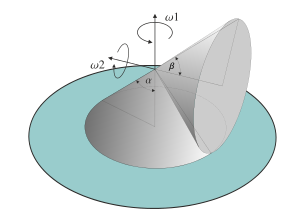Rolling cone motion
The distinguishing characteristic of a rolling cone, in relation to other axially symmetrical rollers (cylinder, sphere, round disk), is that while rolling on a flat surface, the cone's center of gravity performs a circular motion rather than a linear one.
Another unique characteristic is that one of its points (its apex) is at rest throughout the entire motion.
For example, a cone having an apex angle of 60 degrees, while being rolled on a flat surface, will perform exactly two full rotations around its axis of symmetry before returning to its original position.
One of the most practical applications of rolling cones is the use of tapered roller bearings in rotating devices.
A common example is belt conveyors in airport terminals where there's a need to move the luggage in loops.
In the 18th and 19th century rolling cone motion was used in the process of olive oil extraction.
The olives were put in a large circular basin and heavy metal cones were rolled upon them.
The fact that a cone can roll in circles without sliding made it more efficient to use conical roller millstones.
